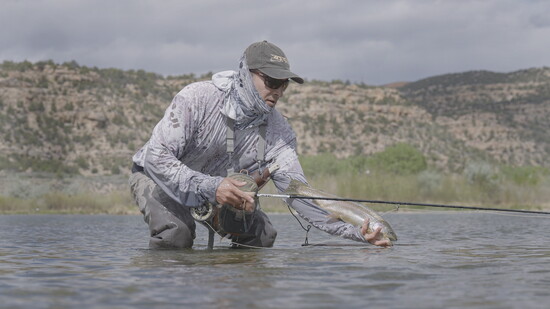Did you know that even as a landlocked desert state, New Mexico provides sportsmen and women some of the best fishing waters in the southwest? New Mexico’s unique climate gives anglers the opportunity to fish year-round at many of the state’s lakes, rivers, ponds, and streams.
The Department of Game and Fish ensures outstanding recreational angling opportunities for the public by maintaining “the quality of the state’s fisheries, improving fish habitat, and restoring native sport fishes.” The Department operates six hatcheries where they’ve been able to raise rainbow trout, bass, and walleye, while also conserving native species such as the Rio Grande cutthroat trout and Gila trout. Between all six hatcheries, the Department stocks roughly 16 million fish per year in state waters.
Prior to enjoying New Mexico’s fishing waters, all anglers 12 years and older must have a valid New Mexico Fishing License or Game-hunting & Fishing License. Licenses are valid from April 1st through March 31st and can be purchased online or at a local vendor. However, a fishing license isn’t required when fishing on tribal reservations and private Class-A lakes. The funds raised from licenses support the continued conservation of New Mexico’s fishery, such as hatchery operations, fish stockings, and habitat enhancement projects.
Some popular fishing waters include Elephant Butte Reservoir, Navajo Dam, the San Juan River, and Heron Lake. Elephant Butte Reservoir is in southern New Mexico and is the state’s largest body of water. Anglers can fish for walleye, catfish, bass, and stripers at the butte. Navajo Dam is located just outside of Farmington in northwestern New Mexico and is the state’s second-largest lake. Navajo Dam is on the San Juan River, which is known amongst anglers as a world-class Rainbow and Brown Trout fishing spot. Heron Lake is tucked away in the mountains of northern New Mexico. It’s known as a great spot to catch trout and kokanee salmon. Because of its location, Heron Lake also offers the opportunity for anglers to ice fish during the winter.
These are just a handful of popular fishing waters. To find other fishing spots, the Department has developed an interactive Fishing Waters Map that provides hundreds of fishing access points across New Mexico. For each spot, the map includes information such as fish species, access details, available facilities, restrictions, and more. It’s important that anglers properly prepare for their fishing activities because each body of water has its own regulations, such as catch and release only, how many fish you’re allowed to catch, and whether bait or tackle can be used.
Thanks to their continuous efforts, the Department of Game and Fish has ensured that current and future generations can make lasting memories out on the water, whether it’s through fishing, swimming, boating, tubing, or canoeing.
